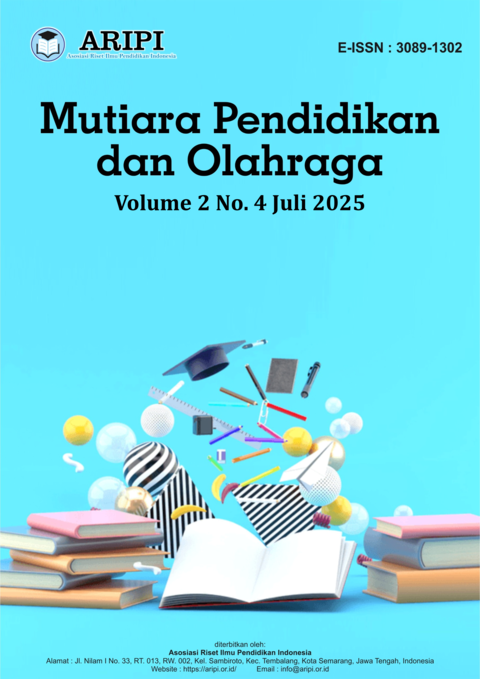Upaya Meningkatkan Hasil Belajar Keterampilan Passing Bawah Bola Voli Melalui Metode Bermain
DOI:
https://doi.org/10.61132/mupeno.v2i4.628Keywords:
Learning Outcomes, Physical Education, Play Method, Underhand Passing, VolleyballAbstract
This study aims to improve the learning outcomes of underhand passing skills through the application of play-based methods to fifth and sixth grade students at SDN 1 Bumijawa. This study used a quantitative approach with a One Group Pretest and Posttest experimental design. The sample in this study was 15 students. Data were collected through underhand passing skills tests conducted before and after treatment. The results showed a significant increase in underhand passing skills after students participated in learning using the play-based method. This method has been proven to be able to increase students' interest, active participation, and understanding of basic volleyball techniques. In addition, the application of the play-based method also creates a more enjoyable learning atmosphere and reduces student boredom. This method directly involves students in practical activities, so that students not only understand the theory but also can apply it in real games. Play activities carried out in small groups allow students to learn from each other and increase self-confidence. Improvement in underhand passing skills also shows that the play-based method is effective in developing fine motor skills needed in volleyball. Therefore, the play-based method can be used as an alternative strategy in learning Physical Education, especially volleyball material in elementary schools. This study suggests that Physical Education teachers implement play-based methods more widely to maximize student learning and learning outcomes, as well as increase their motivation and enthusiasm for sports. Furthermore, implementing play-based methods can also improve teamwork among students, a crucial aspect of volleyball. With a more fun and interactive approach, students are more motivated to practice and master the skills taught.
References
Ahmad Rifa’i, & Anni, C. T. (2009). Psikologi pendidikan. Unnes Press.
Amung Ma’mun, & Saputra, Y. (2000). Perkembangan gerak dan belajar gerak. Departemen Pendidikan Nasional Direktorat Jendral Pendidikan Dasar dan Menengah Bagian Proyek Penataran Guru SLTP Setara D-III Tahun 2000.
Aqib, Z. (2006). Penelitian tindakan kelas. CV. Yrama Widya.
Arikunto, S. (2010). Prosedur penelitian: Suatu pendekatan praktik (Edisi revisi).
Arikunto, S. (2013). Dasar-dasar evaluasi pendidikan. Bumi Aksara.
Arikunto, S., et al. (2008). Penelitian tindakan kelas. Bumi Aksara.
Danapriatna, R., & Setiawan, R. (2005). Pengantar statistika. Graha Ilmu.
Hall, G. E., et al. (2008). Mengajar dengan senang. PT Indeks.
Koesyanto, H. (2003). Belajar bermain bola volley. Unnes Press.
Kurnia, et al. (2007). Perkembangan belajar peserta didik. Direktorat Jenderal Pendidikan Tinggi Departemen Pendidikan Nasional.
Machfud, I. (1999). Pembelajaran permainan bola voli. Depdikbud RI, Dirjen Dikdasmen, Dirdikgutensis.
Soepartono. (2000). Media pembelajaran. Departemen Pendidikan Nasional Direktorat Jendral Pendidikan Dasar dan Menengah Bagian Proyek Penataran Guru SLTP Setara D-III Tahun 2000.
Sugiyono. (2010). Penelitian kuantitatif, kualitatif & RnD. Alfabeta.
Sugiyono. (2015). Metode penelitian pendidikan: Pendekatan kuantitatif, kualitatif, dan R&D. Alfabeta.
Suharno, H. P. (2005). Ilmu kepelatihan olahraga. Yogyakarta.
Sukestiyarno, & Wardono. (2009). Statistika. Unnes Press.
Yunus, M. (1992). Olahraga pilihan bola voli. Depdikbud RI, Dikti.
Downloads
Published
How to Cite
Issue
Section
License
Copyright (c) 2025 Mutiara Pendidikan dan Olahraga

This work is licensed under a Creative Commons Attribution-ShareAlike 4.0 International License.





